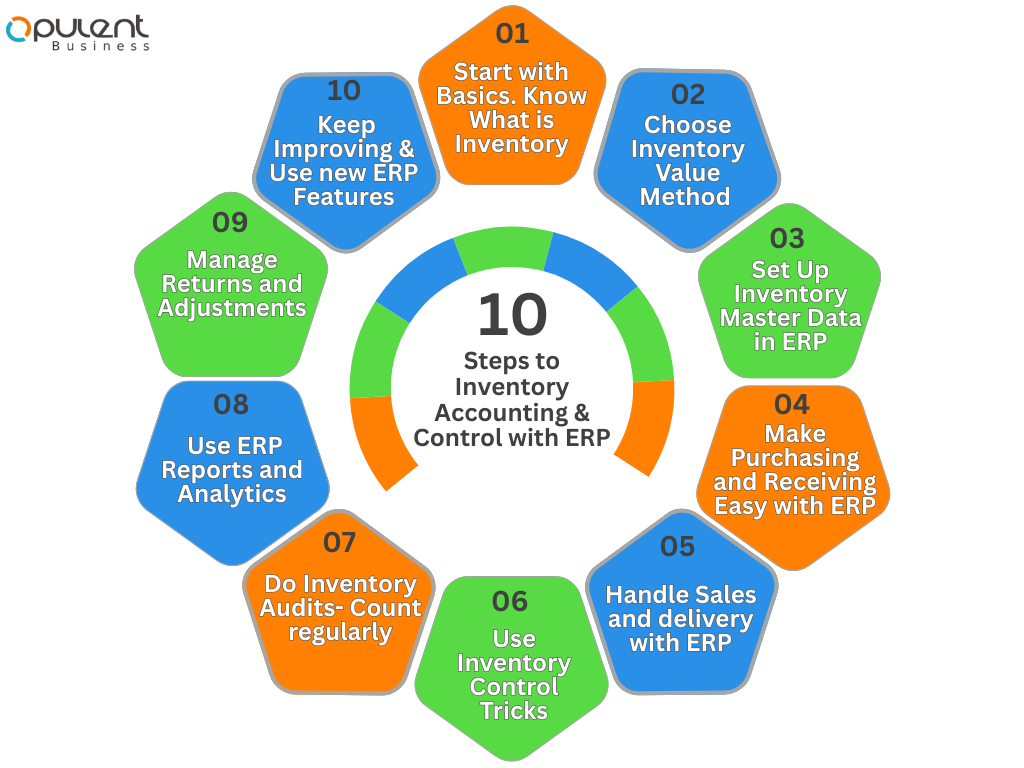Why Inventory Accounting Matters
Inventory accounting plays a critical role in your business management. Inventory is not just items in your shop or warehouse but a big asset for your company. It can change your profit, cash flow, and also if your customers are happy. If you keep a good record of inventory, you don’t buy too much or too little, and you can send orders on time. This is good for your business to work well and make money.
But managing inventory is not simple. You must check every item coming and going, know the real value, and always keep enough stock—not too much, not too little. It needs careful work. Here, the ERP system can help you a lot. It puts all inventory and accounting together, so you can manage everything more easily. It changes how you run your business.
This guide presents 10 essential steps to master inventory accounting and control through an ERP system, empowering your business to operate efficiently and scale effectively

Step 1: Start with Basics—Know What is Inventory
Before you can control inventory, you must understand what it is. Inventory is not just one thing. Usually, it has different types:
- Raw materials that you use to make finished products.
- Work-in-Progress (WIP): the product is not finished yet; it is still in the making.
- Finished goods are the ready products you can sell to customers.
- MRO (Maintenance, Repair, and Operations) Supplies: The things you use in production or for repair, but not for selling.
In accounting, inventory is an asset for your business; you see it in the balance sheet. When you sell inventory, the cost goes to the income statement as cost of goods sold (COGS), and it changes your profit.
The ERP system helps you a lot here. It keeps all types of inventory in one place and makes sure you record everything correctly. This way, your financial reports are also correct.
Step 2: Choose Inventory Value Method—FIFO, LIFO, or Average
How you count your inventory value is very important for your business numbers, like COGS and how much inventory you are left with. There are three main ways:
- FIFO (First-In, First-Out): Here, you sell the oldest items first. If prices are going up, your inventory value looks higher and COGS is lower.
- LIFO (Last-In, First-Out): Here, you sell the newest items first. Some countries, like the USA, use it for tax, but in many other places, it is not allowed.
- Weighted Average: You take the average cost of all items and use this for COGS and inventory value.
The ERP system here helps a lot because it does these calculations for you. You just set which method you want to make sure it aligns with the rules and it will use it every time, so no mistakes.
Step 3: Set Up Inventory Master Data in ERP system
This is very important for good inventory work. In ERP, you must put all details for every item:
- Item Master Files: For each product, you make a profile with SKU, description, unit (like piece, kg, or liter), cost, selling price, supplier, and planning info like min/max stock and reorder point.
- Location/Warehouse: Tell the system where you keep your items—warehouse, section, row, or bin. This helps you track better.
- Supplier and Customer Info: Connect items to main suppliers and customers for easy buying and selling.
- Batch/Lot & Serial Number: If needed (like in pharma or electronics), set ERP system to track by batch or serial for safety and recall.
If you do this right, every transaction is correct, and you get good info from ERP.
Step 4: Make Purchasing and Receiving Easy with ERP
Getting inventory in your business must be smooth.
- Purchase Orders (PO): Make and send POs from the ERP system. You know what you ordered and from whom.
- Goods Receipt Note (GRN): When goods come, record in ERP with the PO. Stock updates in real time.
- Vendor Invoice Match: It checks PO, GRN, and invoice to make sure you pay only for what you got.
- Automation: less manual work, fewer mistakes, better supplier relations, and always having stock when needed.
Step 5: Handle Sales and delivery with ERP
Controlling how inventory goes out is also important:
- Sales Order (SO): Make and track SO in ERP. The system can reserve stock for each order.
- Picking, Packing, and Shipping: It helps the warehouse team pick, pack, and ship better.
- Real-time Stock Update: When you ship or sell, it reduces inventory right away.
- POS Integration: If you have retail or a restaurant, connect POS to ERP so every sale updates inventory instantly.
Step 6: Use Inventory Control Tricks
Not just tracking, but also controlling stock:
- Min/Max Levels & Reorder Points: Set in ERP. If stock is low, it can alert or suggest orders.
- Safety Stock: Keep extra for emergencies. ERP helps you watch this.
- ABC Analysis: ERP can show which items are most important (A, B, C) so you control them better.
- Demand Forecasting: Use ERP sales data to guess future needs and buy smarter.
Step 7: Do Inventory Audits—Count Regularly
Even with an ERP system in place, mistakes can happen. Count inventory to fix problems.
- Why Audits: Audits help find mistakes from damage, theft, or wrong data.
- Cycle Counting: Instead of counting all at once, count small parts often. ERP helps plan this.
- Physical Count: Once a year, do a full count. It helps freeze stock and match numbers.
- Root Cause: If you find mistakes, use ERP history to find why and fix it.
Step 8: Use ERP Reports and Analytics
Here you get real value from ERP:
- Key Reports: ERP gives reports like inventory value, old stock, movement, reorder alerts, and sales vs. inventory.
- Real-time Data: You can buy better, set good prices, plan sales, and improve supply chain.
- Dashboards: Many ERPs have dashboards to see important numbers quickly.
Step 9: Manage Returns and Adjustments
Returns and changes are part of business.
- Customer Returns: Use ERP to handle returns, put back good items or mark damages.
- Vendor Returns: Send back wrong or damaged items to the supplier.
- Inventory Adjustments: Record any changes for spoilage, damage, or mistakes. The ERP system keeps all records for audit.
- Accounting Impact: All changes must show in your accounts. ERP does this automatically.
Step 10: Keep Improving and Use Advanced ERP Features
After all steps, keep making things better:
- Automate: Use ERP to auto-create POs, alerts, and accounting entries.
- Integration: Use ERP for full business—inventory, sales, and accounts all together.
- Supplier & Customer Portals: Some ERPs let suppliers and customers check orders themselves.
- Future-Proof: Watch for new ERP tools like AI, IoT, and better analytics.
Conclusion
Make Your Inventory Work for You
Inventory is not just things on shelves. If you manage it well, you make more profit and run the business better. Follow these steps and use ERP to move from guessing to real control and smart decisions.
With ERP, you get:
- Better cash flow (less extra stock, no stockouts)
- Less waste (not much old or damaged goods)
- Happy customers always have what they want.
- Smarter choices (real-time data)
Ready to change your inventory management?
Learn how OpulentBiz can help you implement these 10 steps for seamless inventory accounting and control. Contact us today for a personalized consultation or schedule a free demo to see our solution in action!

